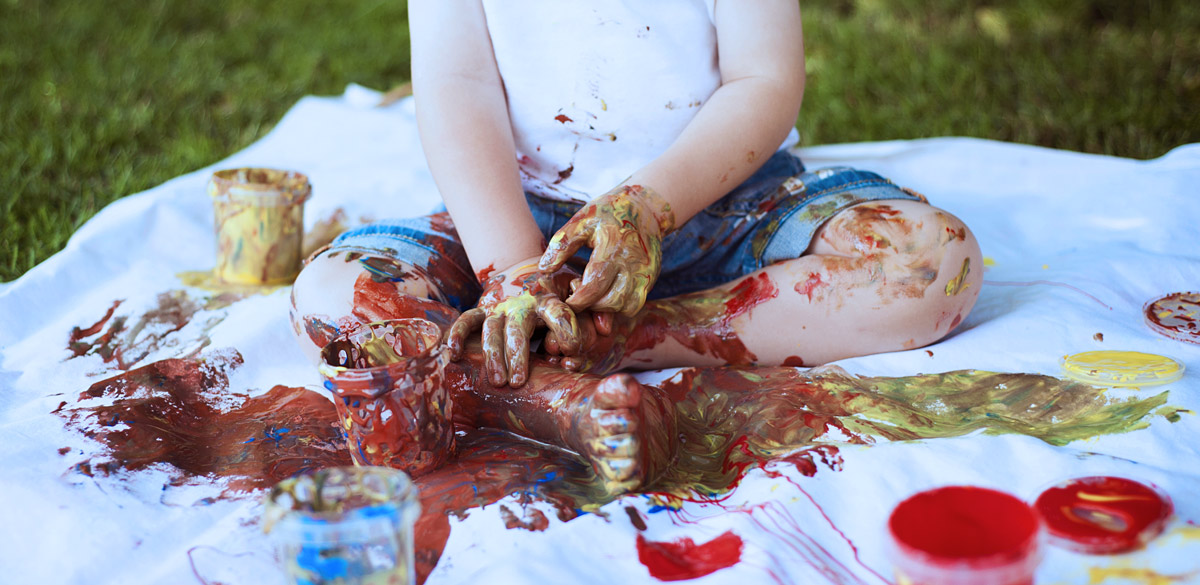

with



remember walking over to where four-year-old Hays was painting and quickly noticing she had taken her artwork beyond the paper. Hays proudly grinned as she looked up at me and said, “I painted myself red.” She had done exactly that; she had painted her entire body red. Instead of freaking out, I calmly said, “Wow, I see a lot of red, how does that feel?” While we cleaned up the red paint, she giggled as she told me that the paint felt cold when it touched her arm, but it wasn’t too cold.
Within minutes she was clean and had moved on to another activity. There was no drama, no fits, no punishment. I was simply honoring Hays and her desire to turn the art experience into a sensory experience. Children are born with a desire to squish, push, transport, and pound—and it is our role as parents to provide the opportunity for these brain-building adventures.
Because sensory play is so beneficial, I believe it is one thing that every parent should make a priority. When children engage in sensory play, it builds nerve endings in their brains, prepares them for more complex learning, and enhances memory. These skills will be useful when your children are older and start attempting math equations and deeper science exploration.
Not only is sensory play beneficial to children’s cognitive development, it is one of the best ways to calm the nervous system. If you have anxious children, try offering them playdough made with lavender or chai tea. Encourage them to manipulate the dough while you read to them or have a conversation. This often helps their body calm and their brain focus.
Sensory play is also a fabulous way to develop language skills. By discussing with your children the variety of materials they are manipulating and exploring, you will be building their vocabulary and strengthening their language skills. Asking open ended questions will get conversations started. Ask things such as, How does that feel? What can we do with that? What do you smell? What could we add? Where do you think that comes from? What should we do next? If multiple children are engaging in the same sensory activity, natural conversations will occur. Often children will turn sensory play into imaginative play. This not only builds their vocabulary, but also cultivates executive function skills in the brain.
With sensory play, children feel true freedom to explore because there is not a product or end result expected. I remember speaking at a conference, teaching parents how to make fly guts (I will share the recipe with you) with their children and a parent asked, “WHY? Why would we make fly guts with our children?”
Because it is fun. So much learning can be taught naturally in the fun.
When children are expected to consistently perform at a young age by getting the activity “right” or completing it according to the instructions, anxiety can develop in the child. This anxiety can hinder a child’s willingness to try new things and can harm their emotional well being. Sensory play builds confidence because young learners can investigate, change the outcome, and take risks without fear of failing.
- Grate two bars of ivory soap (I do this part if it is a very young child).
- Add in lots of toilet paper (about two rolls).
- Pour enough water in to get the consistency you desire. Some people like it very runny and others prefer a stiffer consistency that you can build with. It is up to you, this is a sensory process without an expected end result.

Once the desired consistency has been achieved, enjoy touching, squishing, and squeezing the fly guts. Lots of conversations happen around the title of this experience.
- Use the bathtub. You can add color to the water or offer finger paint or shaving cream with a little liquid watercolor. Provide paint brushes, pipettes, and cups and spoons and your little ones will be excited to jump in!
- Get a large plastic container or even a small swimming pool for sensory play. You can use rice, beans, potatoes to mash, shredded paper, bird seed, mud, nature items, jello, or tapioca pearls. You can add in a variety of items such as animals, cars, plastic eggs, measuring cups, spoons, and other small items.
- Keep about ten to twelve bins with lids filled with sensory ideas ready to go. You can make them theme-based around the holidays, one of your children’s interests, or a topic you are introducing. Some of my favorite themed sensory bin ideas include the beach, birds and more, rainbow rice, gardening, bugs and spring, eye spy, construction zone, dinosaur dig, oodles of noodles, flower shop, and ice cream shop. Just find items that support the theme and add them into the sensory bin. Be sure to rotate these bins on a regular basis to keep interest high!
Sensory play is worth the effort. I promise. Your role is to set the stage and invite your children to explore. If you aren’t sure where to start, I would encourage you to begin with the activity I mentioned above, FLY GUTS.
About thirty years ago as a young school administrator, I had the privilege of discovering fly guts while attending training at a local preschool. I walked over to a young girl who invited me to play. She had her hands deep in this white gooey substance and when I asked her what she was playing with she emphatically stated, “FLY GUTS!”
In reality, it was a mixture of ivory soap, toilet paper, and water—but to young Caroline it was fly guts. From that day forward, whenever I make it with young children, I introduce it as FLY GUTS.
- Why do you think this is called fly guts?
- How does it feel?
- How does it smell?
- What should we do with it?
- Should we add anything to it?
- Where do you think the fly guts came from?
- Why do you think it is this color?
Be flexible with this activity and be willing to follow your child’s lead. Children are always more creative than we adults.


athy Eggers has been in the field of early childhood and homeschooling for over thirty years. She is the mom of ten children, ranging in age from fourteen to thirty-six. Her family has grown to include three grandchildren, with number four on the way. Kathy has taught her children at home since the very beginning, and each year has looked a little different. As a child development specialist, young children have always been her passion. Kathy believes the early years should be full of play and concrete experiences. When given the chance to discover and experience the world first-hand, wonder grows in a child and provides them with a foundation for abstract thinking as they mature. Children who are encouraged to play and figure things out for themselves in the early years are more willing to take risks and problem solve as they become adults. As Mr. Rogers put it, “Play is often talked about as if it were a relief from serious learning. But for children, play is serious learning.”

esli Richards is the co-author of The Homegrown Preschooler and A Year of Playing Skillfully and co-host of the Playing Skillfully podcast. She has had the pleasure of teaching her five children at home for the past eighteen years. Lesli has been married to Brendan for twenty-six years and lives in beautiful North Georgia. She has always loved children and dreamed of having a large, happy family. Her oldest son has autism and had to be taught to play, which sparked her interest in how children learn. Lesli believes that children learn best through play and exploration and loves researching and presenting her findings to parents in a way that is practical and easy to implement. There is so much to discover about how God has wired kids to learn!
